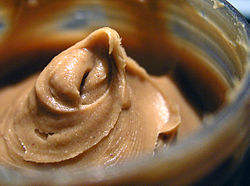**Historical Background of Peanut Butter:**
– Earliest references to peanut butter from Aztec and Inca civilizations
– Marcellus Gilmore Edson obtained the first patent for modern peanut butter in 1884
– George Bayle sold peanut butter as a snack in 1894
– Peanut butter became popular during meat rationing in 1917
– Joseph Rosefield invented smooth peanut butter in 1922
– Invention attributed to George Washington Carver
– Commercial production began in the late 19th century
– Popularized at the 1904 St. Louis World’s Fair
– Became a staple in American households by the 1920s
**Peanut Butter Production Process:**
– Planting, harvesting, shelling, roasting, blanching, grinding, and packaging stages
– Peanuts planted in spring and harvested from late August to October
– Careful shelling to avoid seed damage and control moisture
– Roasting done through batch or continuous methods
– Blanched before grinding into peanut butter
– Different grinds and additives for various types
– Packaging involves cooling, sealing, and distribution
– Quality control measures to ensure consistency and safety
**Nutritional and Health Aspects of Peanut Butter:**
– Nutritional profile per 100g includes energy, carbohydrates, fats, proteins, vitamins, and minerals
– Rich in dietary fiber, vitamin E, pantothenic acid, and other nutrients
– Moderate source of thiamine, riboflavin, iron, and potassium
– Potential allergen triggering severe reactions in allergic individuals
– May help reduce heart disease risk and manage blood sugar levels
– Important food source in combating malnutrition in developing countries
**Cultural and Culinary Significance of Peanut Butter:**
– Common ingredient in recipes like sandwiches, cookies, and candies
– Pairs well with flavors like oatmeal, cheese, bananas, and apples
– Iconic American food associated with nostalgia and comfort
– Used in snacks, desserts, and main courses globally
– Peanut butter and jelly sandwich a classic American favorite
**Economic and Environmental Impact of Peanut Butter Production:**
– Peanut butter industry significantly contributes to the economy
– Creates jobs in farming, processing, and distribution sectors
– Environmental concerns include water usage and waste management
– Emerging sustainable practices in peanut cultivation
– Packaging and transportation also impact the environment
Peanut butter is a food paste or spread made from ground, dry-roasted peanuts. It commonly contains additional ingredients that modify the taste or texture, such as salt, sweeteners, or emulsifiers. Consumed in many countries, it is the most commonly used of the nut butters, a group that also includes cashew butter and almond butter (though peanuts are not botanically nuts, peanut butter is culinarily considered a nut butter).
 "Smooth" peanut butter in a jar | |||||||
| Type | Spread | ||||||
|---|---|---|---|---|---|---|---|
| Main ingredients | Peanuts | ||||||
| Ingredients generally used | Salt, sweeteners, and/or emulsifiers | ||||||
| Variations | Crunchy, smooth | ||||||
| 597 kcal (2500 kJ) | |||||||
| |||||||
| Similar dishes | Nut butter | ||||||
Peanut butter is a nutrient-rich food containing high levels of protein, several vitamins, and dietary minerals. It is typically served as a spread on bread, toast, or crackers, and used to make sandwiches (notably the peanut butter and jelly sandwich). It is also used in a number of breakfast dishes and desserts, such as granola, smoothies, crepes, cookies, brownies, or croissants.
